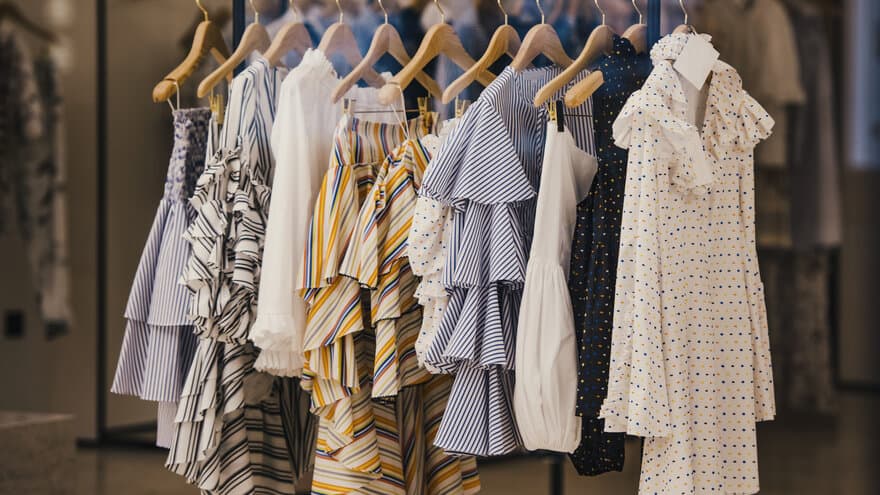The textile industry is notorious for its negative impact on the environment. Could renting clothes be part of the answer? This is what several researchers at NMBU are working to find out.
The textile industry is one of the industries in the world that causes the most pollution. According to the organisation Future in our Hands, textile production accounts for approx. 6.7 per cent of global GHG emissions. The production of new garments also requires vast amounts of water and chemicals.
And if that was not enough: Tonnes of clothes are thrown out every year. In early January, the Norwegian broadcaster NRK broadcast a report from the Atacama Desert in northern Chile, where around 40 tonnes of fashion waste have been dumped in the past year alone. This gave rise to debate about the impact of fashion on the environment, and about what shape a more sustainable textile industry could take.
Goal: To minimise the impact on the environment
One of the actors now taking steps towards more eco-friendly clothing consumption is Fjong, an Oslo-based company that runs a clothes rental service. As a customer, you can either subscribe for new clothes and receive two to five garments each month, or you can hire a garment for special occasions, like a wedding etc.
Over the last few years, Fjong has collaborated with researchers at NMBU, the University of Agder and BI Norwegian Business School on the project ‘Your green, smart and endless wardrobe’. The project, which has been awarded funding from the Research Council of Norway, is investigating the technology, logistics and facilitation needed to succeed in clothes rental on a large scale.
Joachim Scholderer, professor at the School of Economics and Business at NMBU, describes the project as a mix of research and development. Together with Ståle Navrud and Therese Seljevold, professor and senior adviser, respectively, at the School of Economics and Business, he analyses Fjong’s impact on the environment, and tries to find ways to minimise it.
‘We analyse the whole value chain, from production of the garments to how they are packed and delivered to customers. We then develop life-cycle assessments that indicate which stages of the process generate a negative environmental impact. The goal is to help Fjong to optimise its business model, with respect to its environmental impact and profitability,’ says Scholderer.
Two decisive factors
A life-cycle assessment (often abbreviated LCA) is a method of calculating a product’s impact on the environment over the course of its entire life cycle.
‘The mapping must be as detailed as possible, so that we can assess all the potential environmental impacts,’ says Scholderer and explains:
‘We look at the quantity of textiles that go into one garment, how much they weigh and what kind of fibres are used. We then look at what kind of transport is used to transport the garment from the factory to the shop: Then we have to turn our attention to the user: How often is the garment worn, how often is it washed, how is it washed, and how many times can the garment be worn before it is thrown out? And what happens when it is thrown out?
When they have answered all these questions, researchers can then assess what happens to a garment when it is rented. Does anything change, compared with the life cycle of an ‘ordinary’ garment?
‘When we have estimated the environmental impact of these two potential "career paths" for a garment, we can compare them and determine the environmental impact of renting clothes.’
According to Scholderer, two factors determine whether rental is sustainable or not. One is how the garment has been produced, and the other is how the customer uses the service. Does renting clothes mean that the customer does not buy other clothes? This is pivotal to whether the service contributes to more sustainable consumption.
Eco-friendly or not?
Little research has been conducted to date on the environmental impact of renting clothes. But there is some research out there. The results, unfortunately perhaps, are generally pessimistic, according to Scholderer.
A Finnish study that was published in the journal Environmental Research Letters in 2021, concluded for example that rental was one of the least eco-friendly means of acquiring clothes. This was explained by the high CO2 emissions generated from transporting the clothes to customers, and that the clothes had to be dry-cleaned after they were used.
‘However, the study only looked at jeans made from cotton. The production of jeans has a huge, negative impact on the environment. And they are probably an atypical garment for this industry,’ says Scholderer.
Gro Rørvik, research coordinator at Fjong, points out the same thing.
‘We believe the study is not comparable. You shouldn’t rent clothes that you use often. The problem is that only 10–20 per cent of the average Norwegian’s wardrobe falls into this category. Existing studies in the area appear to have misunderstood this point, and are based on garments that would otherwise have been used until they were worn out. It goes without saying, then, that renting these types of garments is not more eco-friendly,’ she says and goes on:
‘The garments you should hire are the ones you don’t wear often. If you rent and share garments, you can have a varied, as well as a sustainable, wardrobe. This reflects the study being carried out at NMBU, and it will therefore be very interesting to see the figures it generates.’
She adds that Fjong only rents out clothes that labels and shops are unable to sell. This means that new clothes are not manufactured for them to rent out.
Scholderer believes that the most important means of reducing the fashion industry’s negative impact on the environment will be to reduce the production of clothes.
‘That is where we see the biggest negative impact. So it’ll be interesting to see at the end of the project whether renting clothes can make at least a small contribution,’ he says
